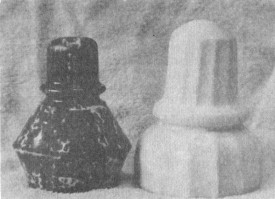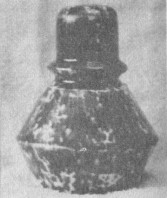"Threadless Corner"
by Ray Klingensmith
Reprinted from "INSULATORS - Crown Jewels of the Wire", January 1978, page 12
Hello to everyone, and welcome to "Threadless Corner", a new column
I hope to be writing each month. Another column called "Patent
Pages" will also be appearing. These three or four pages each month,
hopefully, will be of some help to all those involved in collecting
insulators. This is something I've wanted to do for a long time, so finally here
goes. Hopefully, everyone who has any extra information, photos, etc. to add,
will send the information to me so it can be printed in upcoming issues. I've
gathered quite a little stack of information to date on these "critters".
For the first two or three months I'll be limited to items which I already have
info on. So the items covered will either be those from local collections, or
those which have a special appeal to me. So let's get started on the first jewel
to be covered.
This month we feature the "BENNINGTON" threadless. This particular piece, which happens to be one-of-a-kind, has been assigned U-982
in Jack Tod's Universal Style Chart. It is made of a yellow tan porcelain with a
rich brown mottled glaze. It has an appearance of a yellow insulator which has
been streaked and spotted with the brown glaze that didn't cover the entire
insulator. To quote Jack Tod: "I guarantee you will enter a state of
euphoria if you ever hold this beautiful and unique specimen in your hand."
That is pretty accurate when you see the glaze!

The U-982 Bennington and U-981 Elliott Flint. Classy porcelains
indeed! |

Closer view of the Bennington, showing the unusual glaze in detail. |
This piece has been called "Bennington" because of its
"Rockingham" glaze, for which the pottery works in Bennington,
Vermont, was so famous. Thus the name Bennington. (I believe this particular
item was made in Bennington, Vermont, about which I will go into greater detail
later.) The first pottery works in Bennington, Vermont, was established in 1793
by John Norton. It produced many items, among them a yellow clay crockery with a
rich brown glaze. These items (mostly utilitarian, such as bowls, pans, spittoons,
etc.) with the particular "Rockingham' glaze were introduced in the 1840's.
They were first hand dipped, and in later years spattered while revolving in
a rotating vat. So that's a little history on the glaze, which, by the way, was
also produced by the competitors of the Nortons. These include companies in
Dorset, Middlebury, and St. Johnsbury, Vermont.
So why do I believe it was actually made in Bennington, Vermont, if there
were other companies making the same glaze? Because on October 22, 1853, Gleasons
Pictorial, a Boston publication, had among its articles a large picture and
information on items made at Bennington. In the picture three "paneled"
insulators can be seen (sim. to U-979 and U-981). I believe these were, in fact,
the U-979 and U-981, which were inventions of E. B. Elliot. Elliot also invented
an insulator very similar to the U-982. All of these items appear in an 1850's
catalog.
The "Bennington" and "Elliot Flints' both have a small
"inner skirt" or "skirts". So what we have, in my opinion,
are different types of Elliots manufactured in Bennington, Vermont. Therefore
I'd say the U-982 was also made in Bennington. I would guess the U-982
was made first -- probably late 1840's to early 1850's The Flint types, composed
of flint, feldspar, and quartz, were much stronger. I'd say they were an
improvement over the U-982 in both design and composition. (Some of this info
may be stated in the 1853 article, as insulators are mentioned. Unfortunately,
the copy I have is not complete and isn't very legible.)
The Bennington threadless is without a doubt one of the first insulators to
be "collected". A letter dated Sept. 13th, 1917, was sent by
Percival B. Palmer, 367 West Adams Street, Chicago, to Mr. M. P. Clough, Ocean
Ave., Lynn, Mass. It reads:
|
Dear Sir:
The following may interest you concerning the insulator. Probably will see
you soon as now intend to leave here end of week.
"A relic and great curiosity, especially to Bennington buyers, namely,
one of the first insulators made in this country by the "Bennington"
people directly after the discovery of telegraphy. They have no Bennington mark
and were found to be impracticable and glass was employed instead. They are of
great rarity and represent a part of the beginnings of a world-wide industrial
achievement."
Yours Very Truly
P. B. Palmer |
This letter adds so much to the insulator. It authenticates it as a truly
early piece. Too bad all threadless can't have their history written out on a
piece of paper! Imagine some of the stories they could tell! It's hard to say
exactly how this item came on the scene in 1917. It really makes me wonder how
an item over 125 years old turned up 60 years ago. Who knows?
One thing I'd like to point out is that some of the statements above are opinions
and are based on the facts known at this time. Future findings may disprove some
of these opinions. It's all we have now. Anyone have any additional information?
If anyone has a clear, complete copy of the ad of 1853, I'd appreciate a copy of
it. Thanks.
In April - the super threadless of the month - The UPRR.
|
